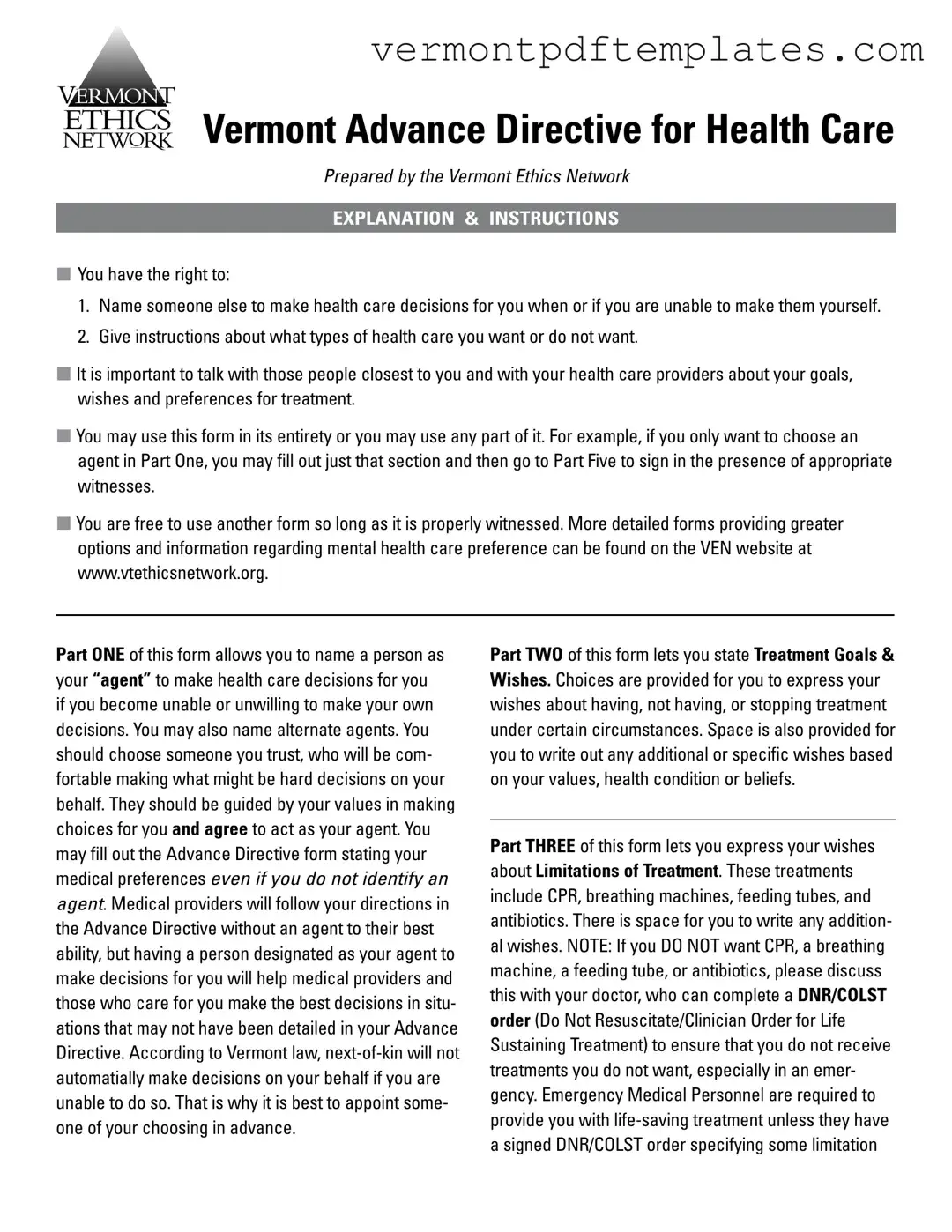The Vermont Advance Directive for Health Care shares similarities with the Durable Power of Attorney for Health Care. Both documents allow individuals to appoint a trusted person to make health care decisions on their behalf if they become unable to do so. This ensures that the appointed agent can act in accordance with the individual’s wishes, reflecting their values and preferences. The Durable Power of Attorney focuses specifically on health care decisions, making it a vital tool for those who want to ensure their medical treatment aligns with their beliefs and desires.
Another document similar to the Vermont Advance Directive is the Living Will. A Living Will allows individuals to express their preferences regarding medical treatment in situations where they cannot communicate their wishes. Like the Vermont Advance Directive, it provides guidance on the types of treatments one would want or not want, particularly in end-of-life scenarios. This document serves to alleviate the burden on family members and healthcare providers by clearly stating the individual's wishes.
The Do Not Resuscitate (DNR) order also parallels the Vermont Advance Directive. A DNR order specifically instructs medical personnel not to perform CPR if the individual’s heart stops or if they stop breathing. This order can be part of a broader advance directive or stand alone. Both documents emphasize the importance of individual choice in medical emergencies and ensure that a person’s preferences are respected, particularly in critical situations.
Health Care Proxy forms are another related document. Similar to the Vermont Advance Directive, a Health Care Proxy allows individuals to appoint someone to make health care decisions on their behalf. This document is particularly useful in cases where the individual may not be able to articulate their wishes due to illness or incapacity. The proxy acts as a voice for the individual, ensuring that their health care preferences are honored.
The Physician Orders for Life-Sustaining Treatment (POLST) form shares a connection with the Vermont Advance Directive as well. POLST is designed for individuals with serious health conditions who want to make their treatment preferences known. This form translates the individual’s wishes into actionable medical orders, ensuring that healthcare providers are aware of and respect those preferences in emergency situations. Like the Vermont Advance Directive, POLST emphasizes the importance of communication between patients and their healthcare teams.
The Five Wishes document is another comparable option. This document goes beyond medical decisions to address personal, emotional, and spiritual wishes regarding end-of-life care. It allows individuals to express their preferences for how they wish to be treated, who they want to make decisions for them, and what they want their loved ones to know. Similar to the Vermont Advance Directive, it encourages open dialogue about health care preferences and values.
Another important document is the Advance Healthcare Directive, which combines elements of both the Living Will and Durable Power of Attorney. This comprehensive document allows individuals to specify their health care preferences while also appointing an agent to make decisions on their behalf. Like the Vermont Advance Directive, it serves to ensure that individuals' wishes are respected and followed in medical situations where they may not be able to communicate.
The Medical Power of Attorney is also relevant. This document grants a designated individual the authority to make health care decisions for someone else. It is similar to the Vermont Advance Directive in that it focuses on the appointment of an agent, but it may not include specific treatment preferences. Both documents aim to protect individuals’ rights and ensure that their health care choices are honored.
For those looking to understand the key aspects of a transaction, the thorough bill of sale guidelines provide an excellent overview of what is needed to formalize ownership transfers effectively. This form not only outlines the necessary details but also serves to protect the rights of both buyers and sellers during the exchange process.
Lastly, the Health Care Directive is another document that aligns with the Vermont Advance Directive. This document allows individuals to outline their health care preferences and appoint someone to make decisions for them. It emphasizes the importance of clear communication regarding treatment choices and ensures that individuals' wishes are followed, particularly in critical situations where they may not be able to express themselves.
